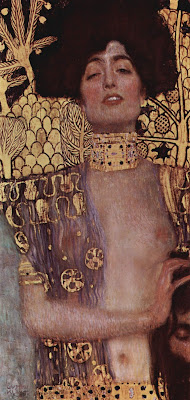
This famous portrait by Gustav Klimt was displayed for years as a "national treasure" in a public palace in Vienna.
Nations fought over it. Teams of lawyers, diplomats and politicians debated the painting's ownership in front of international tribunals. The US Supreme Court analyzed its status under the Foreign Sovereign Immunities Act. Eventually, the picture was purchased for $135 million, the most expensive painting in history up to that time.
But circumstances were very different when the painting was first created.
100 years ago, an 18 year old girl named Adele Bauer was pressured by her mother into an arranged marriage with a wealthy older man. Adele had hoped to pursue her education, but her mother insisted on a high society marriage to corporate mogul Ferdinand Bloch. Adele seemed condemned to a life as a bored society wife, childless and neglected by her husband (who was preoccupied with the family banking and sugar enterprises).

Adele stumbled across Vienna's local Jugendstil art movement and wanted to learn more. She purchased work from promising young artists and promoted their art to her wealthy friends.
One day, Adele summoned the courage to call upon the local artist Gustav Klimt to ask him to paint her portrait. Klimt had a reputation as a brilliant but coarse man who often scandalized polite society. Raised in poverty, Klimt spoke with a thick accent and apparently did not bathe as often as he might. He reportedly wore nothing at all beneath his artist's smock. Models lounged around his studio naked and available for artistic or any other kind of inspirational activity.

The shocked citizens of Vienna accused Klimt of being a "pornographer" because of his blatantly erotic drawings.
Adele soon formed a close relationship with Klimt. Her husband discovered just how close that relationship had become when he saw Klimt's first portrait of Adele displayed at the Secession Exhibition of 1901. She was wearing the gold choker her husband had given her, but little else:
Was Klimt aware of what he was doing when he chose to exhibit the painting?.... displaying a defiantly staring half nude woman...could be both damaging to Adele and an insult to her husband. The Bloch-Bauers received the exhibition in silence.
Adele's friend Alma Mahler hissed, "I always knew Adele was no holy one." But no matter how much polite society clucked and gossiped, Adele continued her relationship with Gustav for nearly a dozen years. Klimt was reportedly fascinated by Adele and helped to introduce her to Vienna's cultural avant garde. She educated herself and established an important salon where leading intellectuals would come and talk. Together with Klimt, she broke out of the cage that society had planned for her.
When Klimt painted the famous "golden portrait" of Adele, above, he covered the painting with these mysterious symbols:

I do not claim to understand these symbols, but an observer might be forgiven for concluding that Klimt was really, really fond of Adele's vulva, and did not care who knew it:

I'm sure that during their private moments together, neither Adele nor Gustav dreamed that Adele's "national treasure" would one day acquire such international importance.
Over the past century, the portrait's sweaty human origins were forgotten in a stampede of bankers, lawyers, accountants and politicians. Respectable elements of society who once felt threatened by Klimt's unruly lusts now acclaimed his painting as "our Mona Lisa." Aging dowagers in elegant ball gowns posed for photographs in front of the painting, proud to be associated with what had now graduated into "high art."
When Klimt painted the famous "golden portrait" of Adele, above, he covered the painting with these mysterious symbols:

I do not claim to understand these symbols, but an observer might be forgiven for concluding that Klimt was really, really fond of Adele's vulva, and did not care who knew it:

I'm sure that during their private moments together, neither Adele nor Gustav dreamed that Adele's "national treasure" would one day acquire such international importance.
Over the past century, the portrait's sweaty human origins were forgotten in a stampede of bankers, lawyers, accountants and politicians. Respectable elements of society who once felt threatened by Klimt's unruly lusts now acclaimed his painting as "our Mona Lisa." Aging dowagers in elegant ball gowns posed for photographs in front of the painting, proud to be associated with what had now graduated into "high art."
As they toasted the painting with expensive champagne, they seemed totally oblivious to Klimt's symbols, or to the human wellspring of art.
